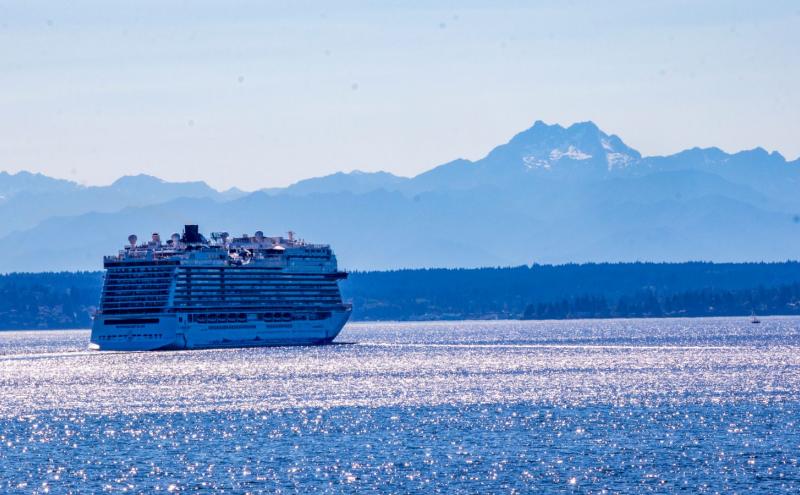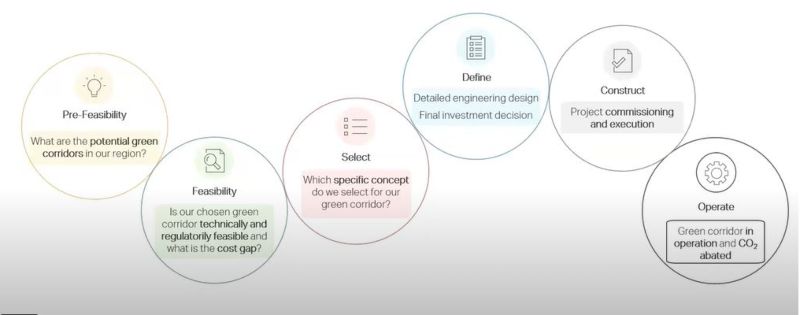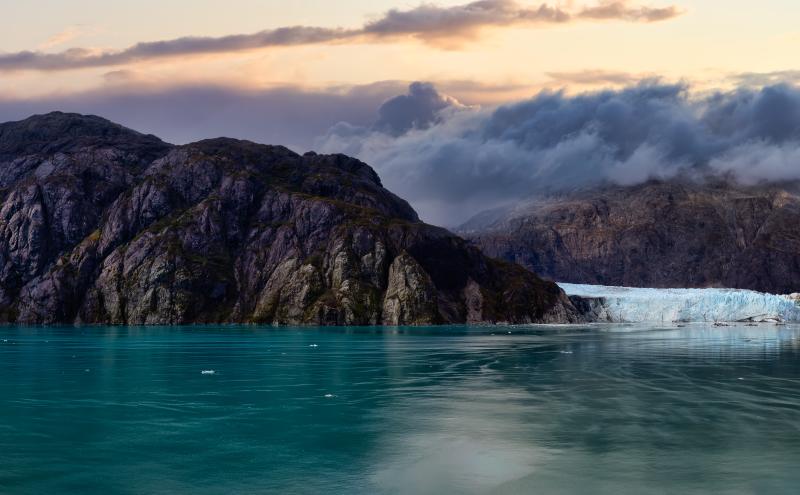
This information is adapted from a webinar held on June 27, 2024. For more detail, watch the webinar recording.
Webinar Participants:
- Vesa Koivumaa, Head of Customer Delivery Wartsila North America, Inc.
- Stephanie Jones Stebbins, Managing Director, Maritime Division, Port of Seattle
- Bob Alton, Senior Director Technical Programs and Decarbonization, Princess Cruises
- Mark Stark, Sustainability Advisor at the Mærsk Mc-Kinney Møller Center for Zero Carbon Shipping
Additional blogs coming:
- Part 2: Green Corridor Feasibility Study (September 2024)
- Part 3: Methanol fuel study (October 2024)
- Part 4: Global Green Corridors (November 2024)
- Part 5: The Future of Green Corridors (December 2024)
The Pacific Northwest to Alaska Green Corridor (PNW2Alaska) for cruise is an ambitious collaboration among 14 organizations to create a new era of low- and zero- greenhouse gas (GHG) emission cruise travel between Alaska, British Columbia, and Washington. Not only is it the first cruise corridor in the world, it’s a complete challenge with aggressive goals and the potential for important impact. First Movers participating in this Green Corridor effort include Port of Seattle; Vancouver Fraser Port Authority; Greater Victoria Harbour Authority; the Alaskan port communities of Haines, Juneau, Sitka, and Skagway; Carnival Corporation; Norwegian Cruise Line Holdings; Royal Caribbean Group; Cruise Lines International Association; the Global Maritime Forum; Blue Sky Maritime Coalition; and Washington Maritime Blue.
Q: What is a green corridor?
A: Vesa Koivumaa, Head of Customer Delivery Wartsila, North America, Inc.
It is a maritime corridor that focuses on accelerating adoption of zero emission fuels and technology. The concept of green corridors emerged in 2021 when 24 countries, including the U.S. and Canada, signed the Clydebank Declaration to launch six green shipping corridors by 2025. In 2022, the Port of Seattle, the Vancouver Fraser Port Authority, and the three largest cruise companies sailing in the Alaska market partnered with the ports in British Columbia and Alaska and non-governmental organizations to explore the viability of a green corridor for cruise.
This particular green corridor will focus on cruise vessel transits from the Pacific Northwest through Vancouver, and up to Alaska. This partnership was assembled two years ago, and we now have an update on progress as the First Movers partners conduct a viability study with the Mærsk Mc-Kinney Møller Center for Zero Carbon Shipping (the Center).
For zero carbon shipping to happen, we are looking at the viability of green methanol to power cruise ships to Alaska within the next decade. The Center has developed a blueprint for assessing the feasibility of green corridors. It is involved in several green corridor efforts around the world and is focused on decarbonizing the maritime industry.

Q: How are we going to reduce emissions from the cruise industry?
A: Congressman John Garamendi, representing the Eighth district of California (in a video statement) with a federal perspective
Well, it's going to be done by somebody stepping up and starting the process. I want to thank the First Movers because that’s what you are doing. We have a piece of legislation that fits this perfectly. It’s to apply the renewable fuel standards presently available for automobiles in the United States and make that available to the shipping industry.
Let’s start with the cruise industry. It must have been 30 years ago that I took my family up the inland passage from Vancouver all the way up to Alaska. It was spectacular. But I also know that that ship was just pushing out a whole lot of diesel smoke.
That’s not going to happen when you get yourselves as the First Movers putting renewable energy into those ships, reducing greenhouse gases as well as the odor.
So go for it. Know that we're there. Know that there's going to be legislation that Representative Miller Meeks and I are pushing through so the renewable fuel standard and the subsidies that go with it will be available to you.
Q: What have the First Movers been working on since the partnership formed?
A: Mark Stark, Sustainability Advisor at the Mærsk Mc-Kinney Møller Center for Zero Carbon Shipping
I'll give you an introduction into who we are, what we do, as well as an overview of green corridors and where the center fits into the Green Corridors ecosystem. Then we'll also take a deep dive into the specific Pacific Northwest to Alaska Green Corridor.
The Mærsk Mc-Kinney Møller Center for Zero Carbon Shipping is a not-for-profit organization based in Copenhagen and founded in 2020 with startup donation from AP Møller. The vision is to sustainably decarbonize the maritime industry by 2050. And our mission is to be an independent and significant driver of sustainable maritime decarbonization. Our strength relies very much within our people and our strategic partners. We have knowledge and academic partners. We have mission ambassadors. And by leveraging all these partnerships we can take the findings from our project. And propel them out into the entire maritime ecosystem.
The Center consists of 150 colleagues spanning disciplines from engineers to economists to scientists and data analysts with around 70 of those colleagues coming from our 24 strategic partners in the form of secondees. I myself am seconded from a V-group, for technical ship managers and I spent 70% of my time with the Center.
The Center, having such a breadth of expertise and diverse workforce in strong range of partnerships throughout the industry, commands a diverse portfolio of projects, all of which are focused on the decarbonization of our industry.
But today we'll just focus on green corridors. So what do we mean when we're talking about green corridors?
Green Corridors are defined as commercial shipping routes where we have commercially operating ships using alternative fuel.
But we do not just focus on the ships. We focus on the entire value chain. So that starts at the production of an alternative fuel. We look at the transport from point of production to the ports and logistics. We look at the vessels that use those fuels and the CO2 emissions which can be abated through the use of those fuels.
We also look at commercial and regulatory drivers and things like the Inflation Reduction Act or the EU's Fit for 55 Policy. As well as the impact on the end consumer by putting a premium on green transportation.
Q: What does it take to launch one specific green corridor?
A: Mark Stark, Sustainability Advisor at the Mærsk Mc-Kinney Møller Center for Zero Carbon Shipping
There are six main phases to a Green Corridor project:

1. Pre-feasibility phase
During the pre-feasibility phase, we look at the fuel production and interested stakeholders in a given geographical area. In the pre-feasibility phase, we’ll usually engage a range of stakeholders to understand all the opportunities that are available to a certain area.
2. Feasibility phase
We take one very defined project such as "cruise ships operating on methanol" and we look to understand the technical and regulatory feasibility of that project throughout the value chain. We also want to understand the cost of that project as compared to when the route is done on traditional fuel like Low Sulfur Fuel Oil (LSFO).
Today’s update will focus only the feasibility phase. We simply want to understand what will it take to make this Green Corridor happen? To date, we have examined:
- the different vessel segments
- different fuels that are available
We then put out a range of options for green corridors and we look to find where is the commitment, where is the funding, and what is the gap?
3. Selection phase
If we can find the funding, the project moves into the select phase.
4. Define phase
Detailed engineering design and final investment decisions are made to unlock the construction and subsequent operation of green corridors.
5. Construction phase
The project is commissioned and executed.
6. Operation phase
What we see is that as you go throughout these six phases the uncertainty of what you're investing in decreases and the commitment of the parties increases.






